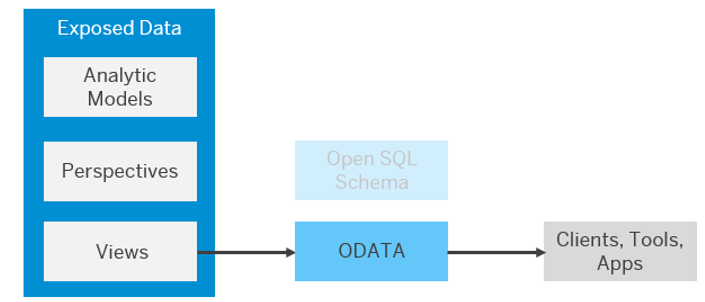Power BI is a powerful business intelligence tool that offers numerous benefits and capabilities, making it an asset for any organization. Data visualization, data integration, data exploration and analysis, collaboration and sharing, natural language querying, advanced analytics and AI integration are some of the key features to leverage organizational data effectively, make informed decisions, and drive business growth by providing intuitive data visualizations, robust analytics capabilities, and seamless integration with various data sources.

The integration between SAP Datasphere and Power BI enhances the capabilities of both platforms, enabling users to leverage SAP Datasphere’s data sources within Power BI for comprehensive data analysis, visualization, and reporting. This integration promotes data-driven decision-making, improved collaboration, and greater agility in responding to business insights.
This article gives an overview on the process of consuming SAP Datasphere data. Our free guided documentation shows how to connect SAP Datasphere with Power BI using OData Service. By utilizing the OData API, users can seamlessly access and incorporate SAP Datasphere data into their preferred analytics and visualization environments.
Before going into detail, we address some basic questions frequently asked by many enterprise reporting users and developers alike.
Connecting Power BI With SAP Datasphere: Options
You can connect Power BI with SAP Datasphere using the following options:
- Import data: Power BI imports data from SAP Datasphere into Power BI. You can extract the necessary data from SAP Datasphere and load it into Power BI for analysis and visualization. Power BI provides various connectors such as ODBC, OData, SAP HANA, etc. that can be used to connect to the underlying data sources.
- APIs and custom integration: SAP Datasphere provides a comprehensive set of APIs that allow you to integrate and interact with the platform programmatically. You can leverage these APIs to build custom integrations between Power BI and SAP Datasphere, enabling you to extract data, perform transformations, and load it into Power BI.
It is important to note that due to the ongoing development topic of SAP and Power BI many new options may be introduced, depending on the versions and configurations of both Power BI and SAP Datasphere.
To connect SAP Datasphere with Power BI using OData Service, please refer to our detailed step-by-step guide, provided as a free download.
Blank Query Versus a DirectQuery Type Connection
In Power BI, a blank query refers to an empty query that does not retrieve any data from a data source. It is a blank canvas within the Power Query editor where you can define custom logic, calculations, or transformations using the Power Query language. In comparison, DirectQuery is a specific mode of connectivity in Power BI that allows you to connect to a data source and query the data in real-time without importing it into Power BI. This mode is typically used for large datasets or when you require up-to-the-minute data accuracy.
Blank Query and DirectQuery are two separate concepts that serve different purposes. DirectQuery focuses on the real-time connectivity to data sources, while a blank query provides a starting point for building custom data transformations within Power Query editor.
In this context we will focus on connecting via blank query.

Access to SAP Datasphere
A login into SAP Datasphere is not required if a user needs to work with its data. Using a DW consumer role, a user can consume data exposed by SAP Datasphere spaces of which they are members even if they cannot log into SAP Datasphere itself.
This consumer role is intended for business analysts and other users who use SAP Datasphere data to drive their visualizations.
Types of Services Provided by OData APIs
The SAP Data Warehouse Cloud OData APIs can be used to replicate data via APIs following the OData version 4 standard. It is divided into two services:
Catalog service allows consumers to list and query all accessible spaces and entities, which are available to a specific user and exposed for consumption. All entities have references to their consumption services.
The main entry point for the SAP Datasphere Cloud OData API is:
https://your-dwc-tenant….sap/api/v1/dwc/catalog/
This is the root URL that should be used when creating OData connections with the intent to list catalog definitions.
Consumption service allows the consumption of the data from specified entities in a space. The data can be consumed in two fashions: as plain relational tables or as analytical models. Also, rich metadata definitions about the entity are exposed allowing consumers to derive detailed information about each column, dimension, or measure.
The main entry point for the SAP Data Warehouse Cloud OData API is:
https://your-dwc-tenant….sap/dwaas-core/odata/v4/catalog/
Data Security Aspects
Within SAP Datasphere, the implementation of data access controls enables the application of security measures at the row level for your objects. By employing data access control on a data layer view or a business layer object, users who access the data will have restricted visibility to only those rows for which they possess authorization, as determined by the specified criteria. If data access controls have been applied, then the data you can consume will be filtered based on your user ID.
Note: The definition of data access control can have an impact on the persistence of a view. Depending on the location where the data access control is configured, it may potentially restrict you from persisting a view.
Consuming data from SAP Datasphere in Power BI allows users to leverage the powerful data analysis and visualization capabilities of Power BI for deriving insights and making data-driven decisions. By establishing a connection between Power BI and SAP DWC, users can access and analyze data in real-time or near real-time, enabling them to stay up to date with the latest information. As the capabilities and integration options may evolve over time. It is important to stay up to date with documentation to understand any specific considerations or limitations related to the consumption of data from SAP Datasphere in Power BI.
Please refer to this detailed step-by-step guide on connecting SAP Datasphere with Power BI using OData Service is available as a free download.
